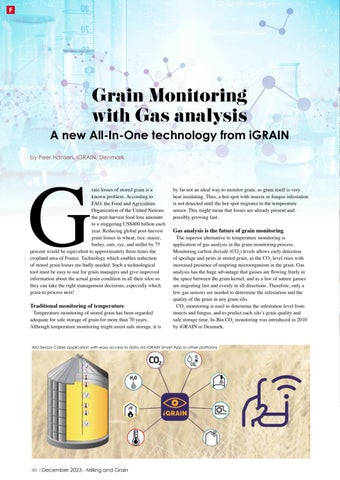F
Grain Monitoring with Gas analysis
A new All-In-One technology from iGRAIN
G
by Peer Hansen, iGRAIN, Denmark
rain losses of stored grain is a known problem. According to FAO, the Food and Agriculture Organization of the United Nations the post-harvest food loss amounts to a staggering US$400 billion each year. Reducing global post-harvest grain losses in wheat, rice, maize, barley, oats, rye, and millet by 75 percent would be equivalent to approximately three times the cropland area of France. Technology which enables reduction of stored grain losses are badly needed. Such a technological tool must be easy to use for grain managers and give improved information about the actual grain condition in all their silos so they can take the right management decisions; especially which grain to process next!
Traditional monitoring of temperature
Temperature monitoring of stored grain has been regarded adequate for safe storage of grain for more than 70 years. Although temperature monitoring might assist safe storage, it is
by far not an ideal way to monitor grain, as grain itself is very heat insulating. Thus, a hot-spot with insects or fungus infestation is not detected until the hot-spot migrates to the temperature sensor. This might mean that losses are already present and possibly growing fast.
Gas analysis is the future of grain monitoring
The superior alternative to temperature monitoring is application of gas analysis in the grain monitoring process. Monitoring carbon dioxide (CO2) levels allows early detection of spoilage and pests in stored grain, as the CO2 level rises with increased presence of respiring microorganism in the grain. Gas analysis has the huge advantage that gasses are flowing freely in the space between the grain kernel, and as a law of nature gasses are migrating fast and evenly in all directions. Therefore, only a few gas sensors are needed to determine the infestation and the quality of the grain in any grain silo. CO2 monitoring is used to determine the infestation level from insects and fungus, and to predict each silo’s grain quality and safe storage time. In-Bin CO2 monitoring was introduced in 2010 by iGRAIN in Denmark.
AIO Sensor Cable application with easy access to data via iGRAIN Smart App or other platforms
60 | December 2023 - Milling and Grain
